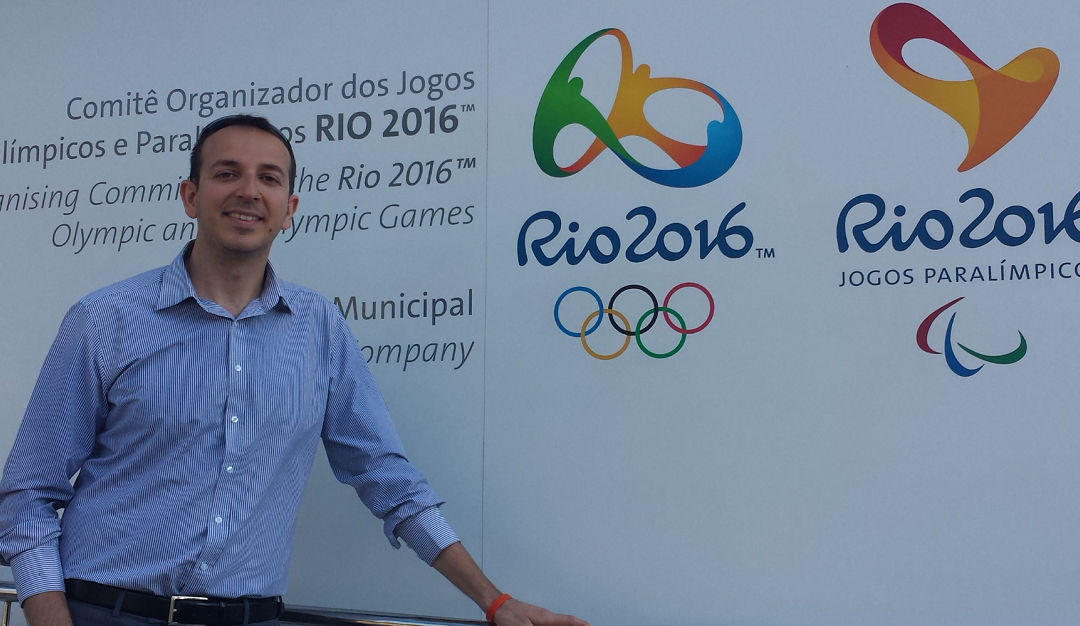By Sasha Milam. Originally published in the summer 2019 issue of Business Class magazine.
Once every two years, the Olympic Games blaze like a meteor across international headlines. For a few weeks, the Games seem to be on every tongue, front page and television. And then, just as suddenly, they’re gone.
Like the proverbial iceberg, however, what you see on camera is only a tiny percentage of what goes on behind the scenes.
“Olympic organizing committees begin their work seven years before the Games actually begin,” explains Arda Ates, MBA ‘06. “Bid committees, which put forward the proposal for a particular city to host, get started about nine years before the competition.”
Ates himself has built a career setting the stage for this ultimate athletic performance as he specializes in planning and delivering venues and overlay. Ates made his Olympic debut as a project manager of overlay commodities and venue infrastructure for the 2010 Vancouver Winter Olympics and Paralympics, shortly after completing his MBA.
“To me, those were the best games,” says Ates. “The energy was incredible. We were all working like mad and it was just a week or so until show time. I remember my boss, who was on his 11th major games, telling us, ‘Right now, you hate your life. You are asking yourself, why am I doing this? But two weeks after the games, you’ll be asking me, when is the next one? Where are the next games?’ It’s a bug, and once you have it, you keep going.”
This has certainly proven true for Ates. To date, he has been a part of two Olympic organizing committees (Vancouver 2010 and London 2012), two Olympic bid committees (Budapest 2024 and his native Istanbul (2020), the 2015 Pan American Games (Toronto), the 2018 European Championships (Glasgow) and many other international sporting events.
“For the past 11 years, I’ve been working to spread the power of sports around the world and promote the positive changes that come with it,” explains Ates. “My expertise is in planning games development, creating strategic master plans for venues and sports and implementing event management framework. This consists of leading the planning, delivery and operations of multiple events, including onsite operations.”
Olympic organizing committees are their own unique business environment, often employing 6,000 people in functional areas such as medical, security, finance, marketing, venues, sports and more.
“The venues and overlay team alone is up to 600 people for an Olympic Games,” says Ates. “We are responsible for everything about the physical structure. We decide which existing venues can be used as they are, which need to be renovated or adapted, which will be purpose-built for the games and which will be temporary. And then there are all the add-ons that will be made to the venue, which constitutes the overlay.” Overlay, he explains, encompasses everything from grandstands to water infrastructure, audio-visual equipment and the generators to make it all run. Basically, overlay is “everything that would fall out if you picked the venue up, turned it upside down and shook it.”
A single Olympic Games requires more than 45 venues, so athletes can practice, warm up and compete. Thousands of temporary seats may be needed for any given venue. Add millions of spectators, athletes from around the world and business processes that change depending on the host country, and one can imagine the potential for the unexpected to happen, despite years of planning.
“For this job, you need an operations mind,” says Ates. “You need to have analytical, organizational and planning skills, but you also have to be flexible and able to prioritize ruthlessly, or you’re lost. You also need to be an optimist because so many things can go wrong.”
“During the Vancouver Olympics, I happened to be at the Richmond Olympic Oval when there was an issue with the temporary stairs — one of the steps came out or something. They ask if I can help and I’m in there with the duct tape and the zip ties, helping them fix the stairs. I’m a senior manager working with all the venues across the games, but in that moment, roles, titles, they don’t mean anything. Everybody’s there, hands-on, finding the solution.”
Who better to be on site than a mechanical engineer with an MBA and project management professional certification? Ates has drawn on all these skills in turn. He can build the strategy, manage the budget – and fix the stairs when one breaks 15 minutes before thousands of people turn up.
“If you want a real challenge, if you want to be under the spotlight, making decisions and problem-solving under enormous pressure with no excuse for delays, and if you like teamwork, it’s the job for you.”
Photo: Courtesy of Arda Ates


